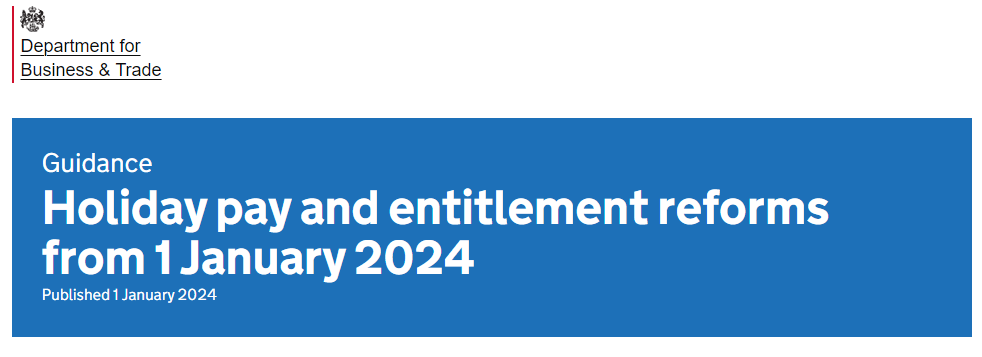Holiday Pay Reforms from 1 Jan 2024
03/02/2024 - 2 minutes readHoliday Pay reforms from 1 Jan 2024 simplify holiday entitlement and holiday pay calculations in the Working Time Regulations.
What is an Irregular hours worker?
A worker is an irregular hours worker, in relation to a leave year, if the number of paid hours that they will work in each pay period during the term of their contract in that year is, under the terms of their contract, wholly or mostly variable.

What is a Part-year worker?
A worker is a part-year worker, in relation to a leave year, if, under the terms of their contract, they are required to work only part of that year and there are periods within that year (during the term of the contract) of at least a week which they are not required to work and for which they are not paid. This includes part-year workers who may have fixed hours, for example, teaching assistants who only work during term time, and who are paid only when working.
These new rules can be introduced for part-year/irregular hours workers for holiday years that start on or after 1 April 2024 – so if your holiday year runs from January to December, this accrual method and/or rolled-up holiday pay can be used for these workers from 1 January 2025.

Holiday entitlement for irregular hours workers and part-year workers
How statutory holiday entitlement is accrued as per Holiday Pay reforms from 1 Jan 2024
For workers who are not irregular hours or part-year workers, there is no change in how their statutory holiday entitlement is accrued. The method remains so that in the first year of employment, workers receive one twelfth of the statutory entitlement on the first day of each month. After the first year of employment, a worker gets holiday entitlement based upon their statutory and contractual entitlement. Their entitlement will be based upon the proportion of a week which they are contracted to work. This is known as ‘pro-rating’.
For leave years that begin before 1 April 2024, holiday entitlement will continue to be calculated in the same way for irregular hours and part-year workers. Use the holiday entitlement calculator to work out entitlement.
For leave years beginning on or after 1 April 2024, there is a new accrual method for irregular hour workers and part-year workers in the first year of employment and beyond. Holiday entitlement for these workers will be calculated as 12.07% of actual hours worked in a pay period as per Holiday Pay reforms from 1 Jan 2024
Example of how statutory holiday entitlement is accrued under Holiday Pay reforms from 1 Jan 2024
Amanda works irregular hours and is paid monthly. Her leave year starts on 1 April 2024. She is entitled to the statutory minimum holiday entitlement only.
In June, she works 68 hours. To work out how much holiday she accrues in June, you will need to calculate 12.07% of 68 hours.
Calculation of statutory holiday accrual for irregular hours and part-year workers
| Step | Calculation method | Example |
|---|---|---|
| 1 | Divide the hours worked in pay period by 100 | 68 ÷ 100 = 0.68 |
| 2 | Multiply the answer to Step 1 by 12.07 | 0.68 x 12.07 = 8.2076 |
| 3 | Round up or down to the nearest hour | 8.2076 becomes 8 |
Answer: Amanda accrues 8 hours of holiday during the month of June.
Note: the hours can be rounded down (to zero if it is less than 30 minutes) but will be rounded up to one hour if it is 30 minutes or more than 30 minutes.
The 12.07% figure is based on the fact that all workers are entitled to 5.6 weeks’ leave. This means that a worker’s total working weeks in a year is 46.4 (52 weeks in a year minus 5.6 weeks of leave). 12.07% of 46.4 is 5.6.
This figure is based on the statutory minimum holiday entitlement (5.6 weeks). An irregular hour or part-year worker may be entitled to more than the minimum, if this is specified in their contract.
To find the relevant percentage for these workers, you would need to do the following calculation: (total holiday entitlement ÷ remaining working weeks in the year) x 100.
For example, if a part-year worker is entitled to 6 weeks of leave as per their contract, then:
6 ÷ 46 = 0.1304
0.1304 x 100 = 13.04
Therefore, this worker’s holiday entitlement would be calculated as 13.04% of actual hours worked in a pay period.
The accrual method to work out entitlement will apply to an agency worker if the agency worker’s arrangements fall within the meanings of both a “worker” (as already defined) and either an “irregular hours worker” or a “part-year worker”, as per the new definition in the Working Time Regulations.
An agency worker who is a “worker” but not an “irregular hours worker” or a “part-year worker”, will continue to accrue leave at one twelfth of their entitlement at the start of each month during their first year of employment.
Statutory paid holiday entitlement is limited to 28 days. For example, staff working 6 days a week are only entitled to 28 days’ paid holiday.
How can MCL Accountants help with your queries on Holiday Pay reforms from 1 Jan 2024?
Contact MCL Accountants on 01702 593 029 if you would like us to answer your queries on the Holiday Pay reforms from 1 Jan 2024 or if you need any assistance with the preparation and submission of your business accounts or self-assessment tax returns to HMRC.
- ABOUT
- REQUEST A QUOTE
Ishan provides financial management, taxation and transactional advice to business entities of all sizes. His expert areas include statutory compliance, business taxation, personal tax & transactional processing and systems. Industry sectors include professional services, retail, hospitality and entertaining & media and advertising services.

0 Comments